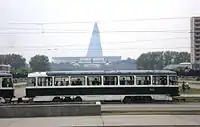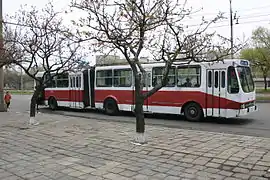Trams and trolleybuses in North Korea
Trams and Trolleybuses in North Korea are forms of public transportation for North Koreans to travel around in urban centres given the shortages on fuel and access to cars for average citizens.




Very few details are known about these trolleybuses and trams due to the closed society of North Korea. Pyongyang, Wonsan and Chongjin are the only cities known to have tramways.
For a full list of trolleybus systems in North Korea, see List of trolleybus systems in North Korea.
Trams
| Fleet Size | Description | Make | Fleet # | Year acquired | Notes |
| 45 | double-articulated | 1001–1045 | 1990 | ||
| 129 | trams | 1046–1174 | 1990s | ||
| 50 | articulated trams | 1175–1233
not all numbers used |
ordered 1991 | modified derivative of Tatra KT4 built in China, articulation later removed due to structural defects and subsequently withdrawn in 1999. Bodies were rebuilt into Chollima 971/961 trolleybuses.[2] 2.5 meters wide instead of 2.2 on normal KT4. | |
| 160 motor units and 160 trailers | trams | single motor units |
2000-3000s | ordered 1998 | used trams from Leipzig (200 vehicles), Dresden (95), and Magdeburg (25). Ordered to replace KT4K.
Only operating on Line 2 and 3 |
| 20 | trams | 1178-1204;
178-204 |
ordered 2008 | Only operates on Line 1, some fleet numbers are not in use. | |
| 1 + 1 trailer | articulated trams | named '7.17' or 'Chongnyonjonwi'[3] |
1991 | Prototype vehicle, not in service. Occasionally displayed at Three Revolutions Exhibition.[4] | |
| 18 trailers and 18 motor units | two-car married sets, each car having two trucks | retired by Zürich in 1994; purchased by North Korea in 1995 | used on a metre gauge line from Samhung metro station to Kumsusan Memorial Palace in Pyongyang (all other lines are standard gauge) | ||
| ≥13[5][6] | double articulated | 1003-1024, 2014, 3023- 3073, not all numbers used | 2018- | Only 1003 is a bidirectional vehicle, all others have cabs on one side only; configurations in pantographs, rear view mirrors vary. | |
| ? | single unit tram | 2020- | Narrow gauge trams (1000mm or 1067mm) for Wonsan.[7] | ||
| ≥6 | single unit tram | 1115-1138, not all numbers used | 1999- | Four axle tram resembling Tatra T6, but longer. Three doors on right side. | |
| ≥1 | articulated tram | Similar to above tram, but joined at the middle with a Jacobs bogie with six axles in total. Only the front and middle bogies have track brakes. Resembles a longer KT8D5K but without the middle section. |
Trolleybuses
The Pyongyang trolleybus system has been operating since 1962, with a large fleet serving several routes. Due to the closed nature of North Korea, the existence of trolleybus networks in other North Korean cities was generally unknown outside the country for many years, but it is now known that around 12 to 15 other cities also possess trolleybus systems, among them Sariwon, Wonsan, Chongjin and Pyongsong.[9] A few other places have private, very small (in some cases only one or two vehicles) systems for transporting workers from a housing area to a nearby coal mine or other industrial site—or at least did at some time within recent years, such as the city of Sangnong.[10][9] Trolleybuses include both imported and locally made vehicles but are mostly locally made, converted or rebuilt. There are a few local manufacturers of trolleybuses.
In 2020, NK News speculated that North Korea was likely to start a removal of its trolleybus systems;[11] however, with the revival of the network in Wonsan during 2018-19, Sinuiju in 2020 and the opening of a new system in Manpo in 2019 directly contradicts this article. It is also important to note, that according to the The Pyongyang Times, new trolleybuses are still being constructed.[12]
| # | Description | Make | Fleet # | Year acquired | Year retired | Notes |
| trolleybus | Converted from diesel, one model was solar powered demonstrator in Nampo. | |||||
| 2 | articulated trolleybus | 1165, ? | Likely converted from diesel Ikarus 280 due to lack of roof equipment.
Works in Sariwon and are the only two trolleybuses in service there.[16] | |||
| trolleybus | 1950s | |||||
| 2 | articulated trolleybus/
trolleybus |
2002 | Only two built. Articulated trolleybus scrapped (411). Other single unit (509) still in use.[17] | |||
| trolleybus | N/A | 1961 | Late 1980s | |||
| articulated trolleybus | 1963 | Only one preserved vehicle still operatable. Based on LAZ-695 | ||||
| trolleybus | 1970 | Mechanically based on Škoda 706 RTO.[18] Partially withdrawn. | ||||
| trolleybus | 1972 | |||||
| trolleybus | 1974 | Another version built in 1975 exists. Has narrow doors unlike the original Chollima-74.
Also operates in Nampo.[20] | ||||
| trolleybus | 1982 | Some trolleybuses in Sinuiju are refurbished with new Mallima-312 based bodies.[21] | ||||
| trolleybus | 1984 | Late 2000s | Mostly withdrawn.[22] | |||
| articulated trolleybus | 1986 | Mostly withdrawn.[23] | ||||
| articulated trolleybus | 1990 | Both are similar and work in Pyongyang.[24][25] | ||||
| trolleybus | Non-articulate variant of Chollima 90/903.[26] | |||||
| trolleybus | 1996 | Designation applies to derivatives of Karosa B731, B732, C734.[27][28] Has either two or three doors.
Used in Pyongyang, Pyongsong and Sangwon. | ||||
| articulated trolleybus | 1997 | Three axle articulated trolleybus, body from withdrawn Shenfeng KT4 trams. Mostly withdrawn.
Trailer removed on some vehicle to become Chollima 961 | ||||
| articulated trolleybus | 1992 | Similar to the Chollima 971 but without front door. One door in front section and two in rear section.[30]
Built in small numbers. Mostly withdrawn. | ||||
| articulated trolleybus | 1999 | Body from withdrawn Shenfeng KT4 trams.
Similar to Chollima 971, but as a single car. | ||||
| articulated trolleybus | 2003 | Only a few were made | ||||
| articulated trolleybus | 2009 | Variant with flatter front exists.[32][33] | ||||
| trolleybus | 1972 | Some rebuilt with front section resembling Tatra T6.[34] | ||||
| articulated trolleybus | 1985-90 | Three axle articulated trolleybus.[35] | ||||
| articulated trolleybus | 1986 | |||||
| trolleybus | 1988 | Similar to the Jipsam 74. Some rebuilt with front section resembling Tatra T6.[34] | ||||
| trolleybus | Late 1970s | Mostly by 2019 | Most likely entirely replaced by Chollima-321 sent to Kangwon Province as a gift by Kim Jong Un in April 2019.[36] | |||
| trolleybus | January 2018 | First trolleybus with battery power storage, located under the floor, first trolleybus with LED display, 3 doors.[37] | ||||
| trolleybus | July 2018 | Has battery power storage, LED display, 3 doors.[39] Also used in Wonsan. Incorrectly named as Mallima-312 in other sources. Later production versions has longer and straighter side view mirror.
Used in Pyongyang, Wonsan and Huichon. A body is used in Sinuiju using the chassis of a Chollima 84. | ||||
| trolleybus | 2019, 2020 | In 2019, two variants were produced; both were painted in blue and white, with the main difference in the curvature of the front.[40]
2020 first series had three doors, bearing more resemblance to the Mallima-312. Another series of these trolleybuses were built in 2020; the differentiating feature to the first 2020 series was that it featured a 'y' shaped arch above the front wheel, similarly to the Chollima-321 which the earlier series lacked. | ||||
| trolleybus | Late 1980s (I),
Before 2016 (II), 2016-(III) |
(I) largely replaced | Some rebuilt with newer bodies. Only operates in Hamhung-Hungnam region.
Mistakenly called Chongnyonho. | |||
| 3 | trolleybus | 2161, 2166,2167 | 2019- | Built with assistance from Pyongyang Trolleybus Works. 2161 is more flat at the front than 2166-7. |
Notes
- "ST4有轨电车新型铰接转向运动机构的设计". April 1997.
- "Shenyang ST4 — Roster". transphoto.org. Retrieved 10 December 2020.
- "Pyongyang, car # б/н". transphoto.org. Retrieved 25 January 2021.
- "平壌市軌道電車(路面電車)-車両紹介". 2427junction.com. Retrieved 20 July 2020.
- "North Korea, Tatra KT8D5K "Thongil" — Roster". transphoto.org. Retrieved 5 October 2020.
- "At this time. Pyongyang. At the moment". DPRK Today. Retrieved 24 August 2020.
- "Photo: Wŏnsan — Miscellaneous Photos — Kalma Beach Resort Electric Transport". transphoto.org. Retrieved 1 December 2020.
- "Chongjin, Tramway — Roster". transphoto.org. Retrieved 1 December 2020.
- Tarkhov, Sergei; and Merzlov, Dmitriy. "North Korean Surprises". Trolleybus Magazine Nos. 244–6 (July, September and November 2002).
- "Sangnong". transphoto.org. Retrieved 5 October 2020.
- "North Korea may soon cut its iconic trolleybus — a historic symbol of the Kims | NK News". NK News - North Korea News. 21 September 2020. Retrieved 30 December 2020.
- "Trolleybuses turned out". www.pyongyangtimes.com.kp. Retrieved 30 December 2020.
- "Chollima 951 (Ikarus 255)". transphoto.org. Retrieved 2 December 2020.
- "Chollima 951 (Ikarus 260)". transphoto.org. Retrieved 2 December 2020.
- "Chollima 951 (Ikarus 280)". transphoto.org. Retrieved 2 December 2020.
- "Sariwon". transphoto.org. Retrieved 1 December 2020.
- "Chollima 011". transphoto.org. Retrieved 2 December 2020.
- "Chollima 70". transphoto.org. Retrieved 2 December 2020.
- "Chollima 72". transphoto.org. Retrieved 2 December 2020.
- "Nampho, Trolleybus — Roster". transphoto.org. Retrieved 1 December 2020.
- "Sinuiju — Trolleybus Operation Restoration 10.2020". transphoto.org. Retrieved 1 December 2020.
- "Chollima 84". transphoto.org. Retrieved 1 December 2020.
- "Chollima 862". transphoto.org. Retrieved 1 December 2020.
- "Chollima 90". transphoto.org. Retrieved 1 December 2020.
- "Chollima 903". transphoto.org. Retrieved 1 December 2020.
- "Chollima 901". transphoto.org. Retrieved 1 December 2020.
- "Chongnyonjunwi (Karosa B731/B732)". transphoto.org. Retrieved 1 December 2020.
- "Chongnyonjunwi (Karosa C734)". transphoto.org. Retrieved 1 December 2020.
- "CHOLLIMA 971, also named SONYON or CHONGNYONJUNWI | chinesecars". www.chinesecars.net. Retrieved 1 December 2020.
- "Photo: Pyongyang, Chollima Kwanboksonyŏn # 133". transphoto.org. Retrieved 1 December 2020.
- "CHOLLIMA 961, also named SONYON | chinesecars". www.chinesecars.net. Retrieved 1 December 2020.
- "CHOLLIMA 091 (Flat Nose) | chinesecars". www.chinesecars.net. Retrieved 10 December 2020.
- "CHOLLIMA 091 | chinesecars". www.chinesecars.net. Retrieved 10 December 2020.
- "Chongjin, Trolleybus — Roster". transphoto.org. Retrieved 1 December 2020.
- "JIPSAN 85 | chinesecars". www.chinesecars.net. Retrieved 10 December 2020.
- "《조선의 오늘》". dprktoday.com. Retrieved 14 January 2021.
- "平壌市無軌道電車(トロリーバス)車両紹介-千里馬-316型". 2427junction.com. Retrieved 20 August 2020.
- "New-type trolley buses roll off assembly line". www.pyongyangtimes.com.kp. Retrieved 14 January 2021.
- "平壌市無軌道電車(トロリーバス)車両紹介-万里馬-312型". 2427junction.com. Retrieved 2 December 2020.
- "Jipsan 2019". transphoto.org. Retrieved 1 December 2020.
- "North Korea, Sinhungho — Roster". transphoto.org. Retrieved 1 December 2020.
- "Pyongsong, trolleybus # 2161". transphoto.org. Retrieved 14 January 2021.
References
External links
 Media related to Trams in Pyongyang at Wikimedia Commons
Media related to Trams in Pyongyang at Wikimedia Commons Media related to Trolleybuses in Pyongyang at Wikimedia Commons
Media related to Trolleybuses in Pyongyang at Wikimedia Commons- Recording of KCTV 28 December 20:00 news showing new trolleybuses in Chongjin
- Discussion on Chongnyonho
